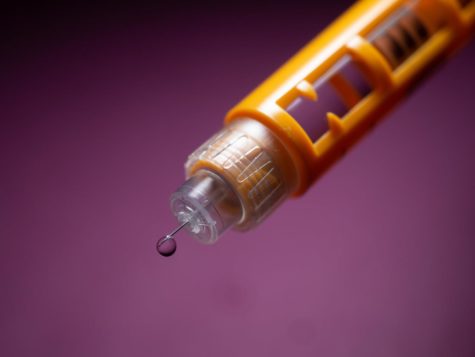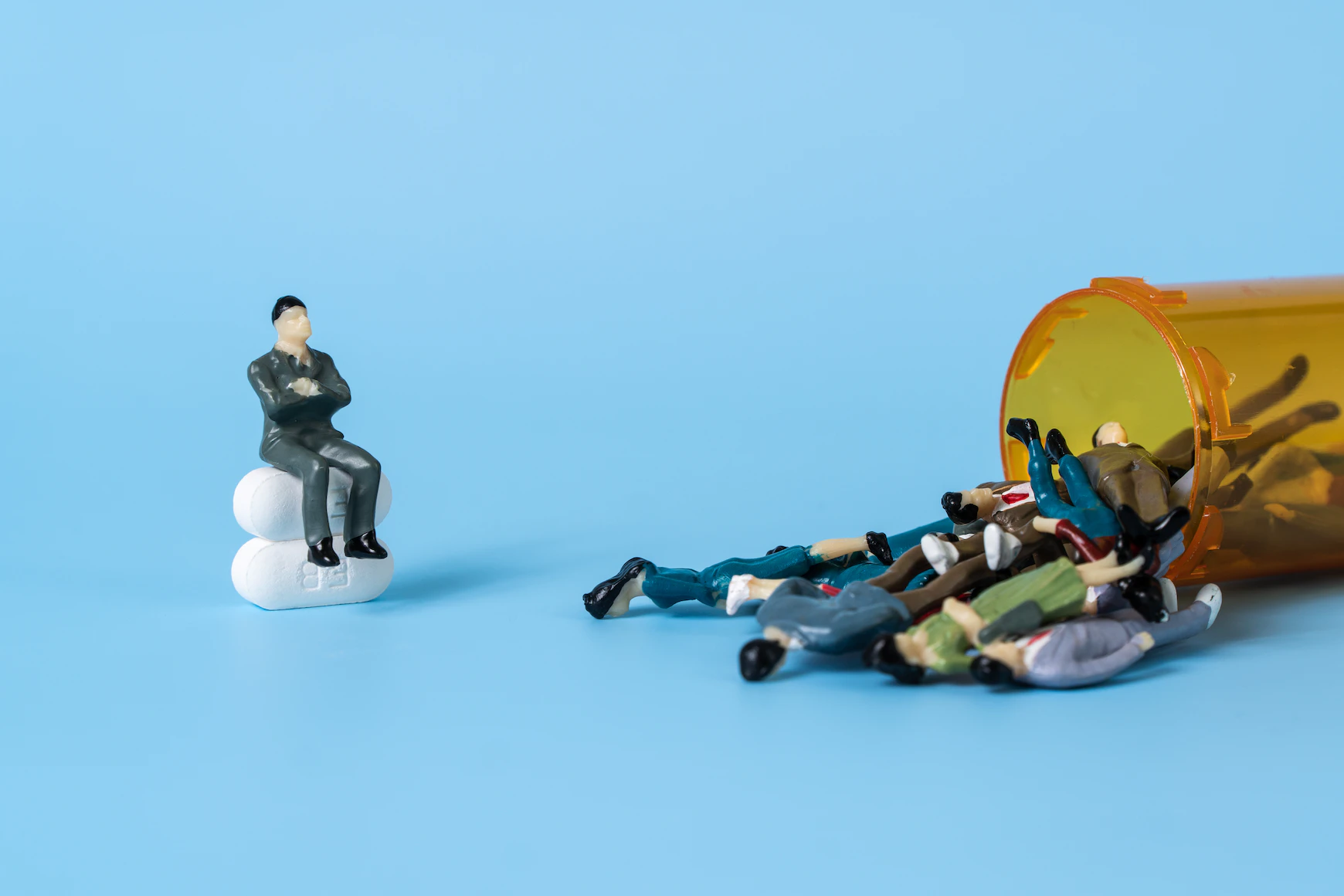America’s Insulin Pricing Crisis
The price of insulin in America is nearly five times more expensive than that of the second most expensive country.
Depicted here is a sculpture of people falling out of a pill vial with a man in a suit sitting on top of pills, representing big pharma’s effect on society.
It is commonly known that Americans pay significantly higher amounts of money for medical drugs than most of the rest of the world, but the price of insulin, a common life saving drug, might shock you.
In America, the average price of insulin, as of 2018, is $98.70 for 10mL. This disproportionately affects people of lower incomes with diabetes. It is a large amount of money to pay regularly for a life-saving medicine, especially when compared to other countries. Chile, the second most expensive country in which to buy insulin, prices it at $21.40. As of 2022, Eli Lilly, one of the main manufacturers of insulin in America, raised their prices to $275, while it only costs $10 to manufacture.
Bernie Sanders, a United States senator from Vermont and a long time advocate for equitable healthcare, recently posted to his social media account, criticizing the greed of pharmaceutical companies, depicting their high prices and their even higher price hikes in recent years.

As per the CDC, 37 million Americans have diabetes, of which over 7 million people require insulin.
JDRF adds that of those, “In the U.S., there are $16 billion in T1D-associated healthcare expenditures and lost income annually.”
Yale furthers this by finding, over 14% of all Americans require the use of insulin, amounting to nearly $6000 per person annually.
Due to this fact, Senator Sanders has called out big pharmaceutical companies such as Eli Lilly, one of the biggest insulin producers in the world, for their unjustified price hikes.
Bernie Sanders wrote, via Twitter in 2022, “Let’s be clear. Eli Lilly should apologize for increasing the price of insulin by over 1,200% since 1996 to $275 while it costs less than $10 to manufacture. The inventors of insulin sold their patents in 1923 for $1 to save lives, not to make Eli Lilly’s CEO obscenely rich.”
This comes after an account on Twitter claiming to be Eli Lilly wrote, “We are excited to announce insulin is now free.”
In this instance, we can see the vast difference between the greed of big pharma today with the exorbitantly large price hikes, contrasted with the desire to help others in the past, noting the transaction of the insulin patent for only $1 in 1923. This was done with the understanding that it would help people and that consumers should have affordable medicine.
Other politicians have similar opinions to that of Senator Sanders. President Biden said, “Imagine what it’s like to look at your child who needs insulin and have no idea how you’re going to pay for it. What it does to your dignity.’”
Raymond March, a writer for The Hill, highlights Alec Smith, a 26 year old with type 1 diabetes, and provides an account on how insulin prices have affected him. He finds, “After turning 26, Alec Smith, a type 1 diabetic, was dropped from his parent’s health insurance plan. With no employer-provided health insurance, Alec soon found himself paying $1,300 a month for insulin…In order to pay his other bills, Alec began rationing his insulin. Less than a month later, he fell into a diabetic coma from dangerously high blood glucose levels. Tragically, he passed away.”
This is incredibly dangerous as rationing insulin can be potentially fatal. A lack of insulin can lead to diabetic ketoacidosis (DKA). This pertains more toward those with T1D, being that they are at a greater risk with the lack of insulin in their body.
This leads us to the criticism big pharma has received for these prices, and the effects of the public’s outrage. After many promises and plans from companies such as Eli Lilly for lower prices they have come up with more price hikes, and a “free supply,” as Eli Lilly states, of insulin for households with income up to 400% of the federal poverty level (FPL) or lower.
Jimmy McDermott elaborates on this thought by noting, “Have a total household income at or below four times (400%) the federal poverty level (FPL)…means that a family of four with an annual income up to $104,800 may receive free medications through the PAP, and for individuals, the annual income limit for participation is $51,040.”

Luckily, Eli Lilly’s Investor website states, “In 2019, Lilly’s solutions helped up to 20,000 people with diabetes each month reduce their out-of-pocket costs for insulin.”
Similarly, Dave Ricks, a publisher for Eli Lilly shares, “…the number of people our medicines are helping – totaled more than 40 million in the past year alone.”
However, there is a large margin between the number of people in need of Eli Lilly’s insulin within this given period and the number of people these lower prices have benefited.
This is why politicians, such as Senator Sanders, are calling out insulin companies for their incessant greed perpetuated over time.
So, finally there is the plan that can be criticized as quite optimistic, the $35/month cap for insulin. The Inflation Reduction Act plans to cap the cost of insulin at $35 per month, but only for seniors with medicare.
Though this policy will be helpful to seniors, these strict eligibility limitations are clear that not all people harmed by insulin pricing will be able to benefit from the Inflation Reduction Act. .
The Associated Press finds, “Only three manufacturers — Eli Lilly, Novo Nordisk and Sanofi — produce insulin, allowing those companies to control much of the market.”
With this cycle in place, Associated Press further notes, “A bipartisan bill proposed earlier this year that would cap insulin prices could cost about $23 billion over the next decade, according to estimates by the Congressional Budget Office. While the bill would reduce insulin costs for many consumers, it would drive up government costs and premiums charged by Medicare and private insurers, according to the office’s analysis.”
The article further quotes Dr. Jing Luo, a professor of medicine at the University of Pittsburgh, who said, “If your health insurance company says, voluntarily, nobody who buys insulin in our plan will have to pay more than $25, the question is who is paying the balance of that? That then means their cost will go up, which means they’ll raise premiums on everyone.”
However, in an episode of NPR’s Morning Edition, correspondent Allison Aubrey explained, “‘Pharmaceutical companies can price a vial of insulin at about $300 when it only costs about $6 to make,’” furthering that the Inflation Reduction Act will do little to help Americans who aren’t on Medicare, assuring that those who don’t have Medicare, will evidently be paying those higher prices.
Whether or not consumers and producers within pharmaceutical companies will be able to come to an agreement on product pricing, one thing is for certain: there will always be a debate on these topics. There is a continuous cycle of the poor being unable to receive adequate life saving products within our monopolistic society due to the reckless actions of the rich.
With more progressive bills being signed, politicians using their positions to raise awareness, and the public opposing this absurd price gouging, change is imminent.
Whether or not consumers and producers within pharmaceutical companies will be able to come to an agreement on product pricing, one thing is for certain: there will always be a debate on these topics. There is a continuous cycle of the poor being unable to receive adequate life saving products within our monopolistic society due to the reckless actions of the rich.
Stephan Chirinian is a Staff Reporter for ‘The Science Survey.’ He finds telling a truthful story very compelling when it comes to journalistic writing....











